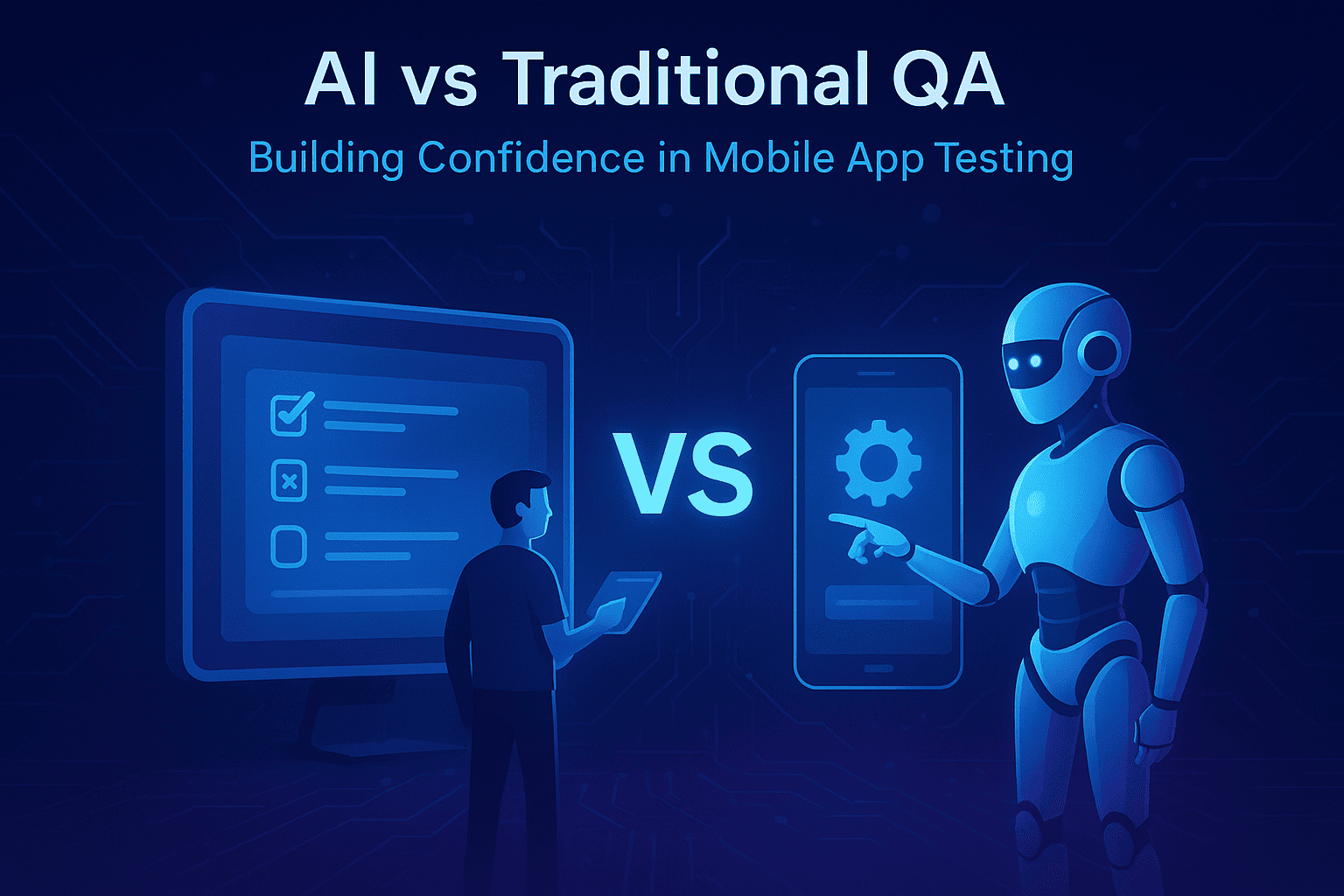Mobile apps today power everything from banking to social networking, but users have little patience for flaky software. One study found 77% of users abandon an app within three days if it fails to engage them. QA is now crucial for user trust and business success. A rigorous QA process ensures that the shipped mobile app works reliably in users’ hands and meets high expectations.
Unfortunately, the current state of mobile QA remains deeply fragmented. Some teams rely on slow manual tests, brittle scripts, or specialized engineers, but none alone guarantees release confidence. Comprehensive testing, as one expert says, “instills confidence” that software works for users. QA should focus on preventing real-world failures, not just on tools or buzzwords.
Traditional Mobile QA is Broken. Here’s Why:
Despite decades of tooling, mobile QA remains plagued by fundamental problems. Manual testing – having humans tap through scenarios on devices – is familiar but slow. It scales poorly as apps grow complex: testers can only execute so many cases in limited device labs or emulators. “manual testing is slow, time-consuming, error-prone” and inevitably leaves coverage gaps that delay releases. On the other hand, scripted automation was supposed to solve this. Teams write UI tests with frameworks like Selenium, Appium, Robot Framework or Espresso to click buttons and verify outcomes.
In theory, automated tests find bugs faster and run constantly. In practice, these scripts are brittle. Even minor UI changes break them, causing maintenance nightmares. Common mobile automation tools (Appium, XCUI, Espresso, etc.) are “cumbersome to implement, time-consuming to manage, and brittle”. Every OS update, screen redesign, or dependency change can require laborious test rewrites. In large apps, QA often ends up hiring expensive SDETs or repurposing developers just to keep the tests running.
Meanwhile, device and OS fragmentation make coverage effectively impossible. There are over 24,000 Android models and dozens of iOS versions in the wild. Ensuring every combination works flawlessly would take years of testing. Even a pool of 20-50 devices covers only a fraction of users. As one QA expert puts it, testing mobile apps is like designing one shirt to fit “every single person on the planet” – an almost impossible task.
The result is that teams must guess which devices and flows matter most. Siloed tooling compounds the problem: many organizations have separate test suites for mobile vs. web, different teams for iOS vs. Android, and disparate frameworks. The end result is inconsistent coverage, tech sprawl, and defects that slip into production.
In short, traditional QA tools fail to deliver true confidence. They focus on individual test cases, not on telling us what’s actually working in the app. Even a suite of 1,000 scripts covers only what developers programmed into it—often just the “happy path” scenarios. Bugs in less-common flows or edge conditions routinely go undetected.
Worse, if a script breaks, QA spends hours fixing it instead of improving coverage. As one QA blogger observes, fragile UI tests create a “maintenance burden” where teams spend more time repairing broken tests than creating new ones. All this effort can leave managers wondering: we have thousands of scripts, but how can we be sure we’re shipping a quality product?
The Real Goal is Confidence, Not Checklists
It helps to remember that QA’s true purpose is confidence in the product, not simply passing a suite of tests. Testing should prove that the app works for real users under real conditions. A mature QA strategy catches bugs early, improves performance, and ensures the software meets user needs. When done right, it becomes a competitive advantage: companies with robust QA deliver better products faster, boosting user trust and satisfaction.
AI-powered QA Testing has shown how to accelerate development: by running nightly tests and continuous integrations, teams can release every sprint without sacrificing quality. Indeed, TestDevLab notes that adding AI to automation can supercharge QA efficiency even further – reducing manual effort, improving test coverage, and speeding up release cycles.
But at its core, confidence comes from covering all meaningful user flows – not just scripted checkboxes. That includes negative tests, edge cases, network failures, performance bottlenecks, and security scenarios. For example, a change to a login screen shouldn’t crash the app for 5% of users on older devices, and QA should catch that. Unfortunately, traditional approaches rarely do. They often miss scenarios (e.g. “What if the user’s session expires mid-flow?”) or assume too much (only happy paths). When these gaps manifest in the wild, they erode user trust and require costly hotfixes.
In response, QA teams and engineering leaders have been eyeing new technologies. Machine learning and AI can automate rote tasks and analyze patterns across vast data. But more importantly, AI offers a new paradigm for testing itself – one built around understanding and verifying real user behavior. The key innovation is shifting from writing brittle scripts to describing expected behavior and letting an intelligent system handle the rest. Instead of manually programming every tap and verification, testers can ask “What should work?” in natural language.
How AI is Revolutionizing Mobile QA
There are multiple approaches organizations are taking to solve this problem. Most of them focus on automating the scripting process. The common method is to use AI, specifically large language models (LLMs), to automatically generate manual test scripts. This creates a no-code/low-code platform for QA, where testers can define scenarios in natural language, and the system converts them into executable scripts.
These platforms usually build on existing frameworks like Appium, Selenium, and Playwright to extend their capabilities. This approach removes some of the grunt work and improves accessibility, but the underlying scripting model still constrains it. At its core, the process stays the same—it’s been automated further but not fundamentally reimagined.
Typically, such tools work by learning an app’s UI, inspecting screens, and identifying elements, so you don’t have to manually code each click or input. They then execute these tests on real or emulated devices, while monitoring app behavior. Advanced systems analyze test results and code changes in real time to predict where bugs are likely by spotting risky patterns.
However, the critical limitation remains: the scripts are brittle. Even when generated by LLMs, they tend to break whenever the UI or flows change. Every small update requires re-authoring or modifying scripts, often through natural language instructions, which adds another layer of maintenance overhead. In practice, this leads to a fragile system—a constant cycle of patching tests rather than building resilient automation.
Once running, AI tools provide instant feedback. Instead of waiting for a nightly test run, teams get real-time insights on flaky tests or failures during each execution. For example, as tests run, the AI can flag “this login test failed on three different devices” and correlate it with a recent code commit. It automatically generates detailed reports: which user flows passed, which failed, and probable root causes. These platforms often include self-healing capabilities as well. When the app’s UI changes—like a button’s label or ID—the AI detects it and updates the test steps automatically.This means one doesn’t constantly scramble to fix broken locators after every minor redesign – the system does it automatically.
From Plain Language to Bug Fix: The New QA Workflow
Some vendors are already pioneering this “AI QA” vision. For instance, Rainforest QA lets testers type a scenario in plain English and generates a full end-to-end test. Instead of coding each step, users can enter something like “Create an account using dummy data,” and the AI handles all clicks, form fills, and verifications. The AI understands the intent, so it covers both normal and edge cases. When the web UI changes (for example, when an element’s label is updated), AI automatically updates the affected test steps to match. This “self-healing” means test suites stay current without manual rewrites. The goal is to shift test maintenance to our AI agents, freeing developers and QA to focus on shipping code.
The benefits are clear: tests become durable, maintenance time drops dramatically, and reliability goes up. Because the AI only reports failures that it cannot adapt to. Teams spend less time hunting phantom bugs and more time fixing real ones. Importantly, AI testing tools often include robust analytics. They can prioritize the most critical tests (e.g. login, payment, main user flows). They can even suggest what to test next based on recent changes. By constantly evaluating risk, they help ensure all relevant behavior is checked.
Under this new model, QA literally becomes as simple as asking “what’s working and what’s not?” in English. Tools take that question and translate it into thousands of underlying test interactions. QA engineers no longer need to “swear by” writing or updating complex scripts. The jargon falls away: no manual test suites, no specialized frameworks, no brittle code. There are just high-level assertions of intended behavior and an AI system that executes, monitors, and reports on them in real time.
Most tools focus heavily on web and browser-based automated testing, while offering more limited and less mature support for mobile and native apps. No one has solved for Mobile app QA testing.
The Future: Zero Tech-Effort QA for Mobile
Looking ahead, the goal is zero technical overhead in QA. In practical terms, that means a unified QA assistant that handles everything from authoring to fixing. Imagine writing a test case in plain language (“When the app launches, ensure the user’s token auto-refreshes in the background”). The AI builds the test, runs it on real devices, and even raises a fix if it fails. If a release accidentally breaks the token flow, the system would not only flag the error but could propose a patch or rollback. QA becomes a continuous feedback loop powered by AI.
This vision aligns with what many engineers want: confidence without complexity. Platforms are emerging that require no scripts or setup: testers simply describe scenarios and let the bot do the rest. They integrate with CI/CD pipelines to automatically validate every code push across all mobile environments. They self-heal and self-optimize, so the test suite evolves with the app. Core features on the roadmap include natural-language input, automated cross-device execution, self-healing UI locators, and instant intelligent reporting. In effect, an AI “assistant” continuously verifies the product, allowing developers and product managers to trust it for QA instead of relying on a growing army of static scripts.
In summary, the future of mobile QA is AI-driven and user-centric. It focuses on giving teams true confidence in their releases without drowning them in test maintenance. By embracing plain language, self-healing automation, and continuous analysis, QA becomes an enabler of speed rather than a bottleneck. For QA professionals, this is a welcome change: testing becomes less about tedious scripting and more about designing quality.
“The moment we recognize what’s wrong, it’s just an MCP away to fix it.”
In practical terms, that means every detected issue leads straight into a Model Context Protocol(MCP) – a quick iteration or patch – guided by the insights the AI provides. It closes the loop between test failure and product improvement.
Ultimately, the shift from traditional QA to AI-powered QA is a philosophical one as much as technical. We’re moving past checking boxes to actively ensure reliability. The only question we need to answer is “what’s working and what’s not?” – for every flow, device, and user scenario. The good news is that cutting-edge tools now exist to make this vision real. They promise QA with zero tech effort: you write in English, the system understands the intent, executes comprehensive tests, and gives you actionable reports. In that future, confidence in mobile software comes not from brittle frameworks or endless scripts, but from an intelligent test loop that works seamlessly behind the scenes.






